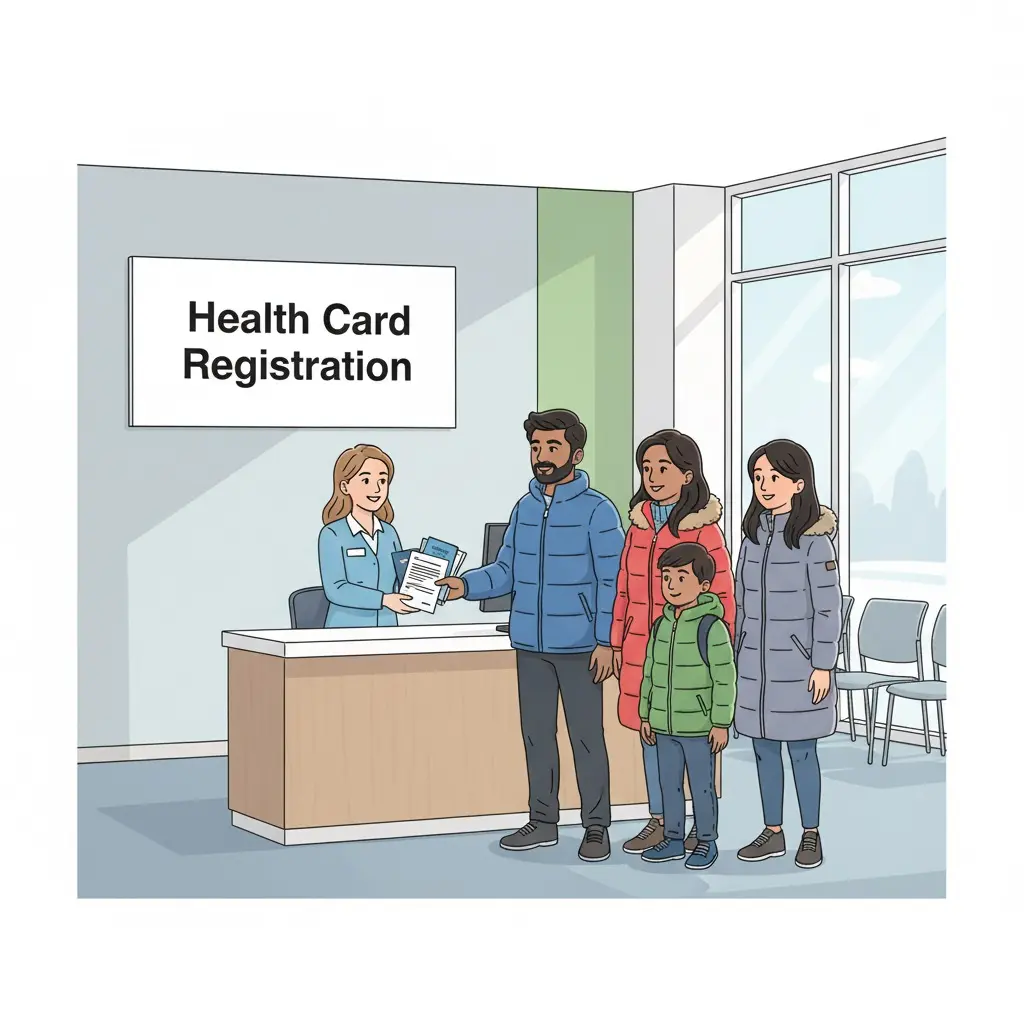New to Ontario or finally sorting out your health coverage? This guide shows who qualifies for OHIP, the exact documents to bring to ServiceOntario, how the “153-day” presence rule works, and practical options if you’re not eligible yet (students, visitors, new workers, refugee claimants, and others).

Quick check: who’s generally eligible for OHIP
You likely qualify if all are true:
- Ontario is your primary home and you meet the physical-presence rules (at least 153 days in any 12-month period and 153 of your first 183 days after settling in Ontario).
- You’re a Canadian citizen, permanent resident, or protected person, or you’re on certain work permits (see below).
- Note on timing: Ontario no longer has a 3-month waiting period for new eligible residents. If you qualify, coverage starts once you register.
Read: Ontario Photo Card vs driver’s licence
How to get an Ontario Health Card (OHIP)?
Apply in person at ServiceOntario with originals:
- Proof of status (citizen/PR or OHIP-eligible status)
- Proof of Ontario residency (shows your name + current address)
- Proof of identity (shows your name + signature)
Accepted examples include: passport or PR card; lease, bank or utility statement; driver’s licence or other government photo ID. Official transcripts or report cards with your Ontario address are accepted at some centres. Bring a backup in case a document isn’t accepted.
Read: Working While Studying
Work permit holders: who qualifies
You may be eligible if you:
- hold a valid work permit,
- work full-time for an Ontario employer, and
- your employment is for at least 6 months (an employer letter is often requested).
Spouses/dependants may also qualify. You must still meet the 153-day presence rules above.
International students: why OHIP usually isn’t available
International students in Ontario are not eligible for OHIP. Universities enrol students in UHIP (University Health Insurance Plan); most colleges use guard.me or similar. Expect around $66/month (≈$792/year) for UHIP; colleges’ guard.me plans are typically in a similar range. Universities usually enrol you automatically (coverage year Sept 1–Aug 31); colleges charge the premium with tuition/fees.
Read: OSAP vs private loans
Step-by-step: registering for an Ontario health card
- Gather documents: one from each of the three lists.
- Go to ServiceOntario: apply in person; you’ll get a temporary paper confirmation if your card is mailed later.
- Keep your address current: report changes within 30 days; renew before expiry (printed on the card). Failure to update can suspend coverage.
If you’re not eligible yet: safe, affordable care options
- School plans (UHIP/guard.me): keep your digital insurance card handy at clinics/hospitals; check exclusions and deductibles.
- Interim Federal Health Program (IFHP): for resettled refugees, protected persons and refugee claimants; covers many services while you wait.
- Community Health Centres (CHCs): many offer primary care and programs even without OHIP; some run non-insured walk-in services.
- Private insurance: short-term visitor or newcomer policies can limit big out-of-pocket costs until you qualify for OHIP (compare carefully; pre-existing condition rules apply).
Mini example (numbers)
Amrita arrives Sept 1 on a study permit (not OHIP-eligible). Her university charges about $792/year for UHIP. A private visitor plan might quote $70–$120/month depending on age and coverage. UHIP is good value and usually required; she keeps it until she later becomes OHIP-eligible through a full-time Ontario job on a 2-year work permit.
Common scenarios
- New PR family: apply for OHIP as soon as you arrive with your COPR/PR card and Ontario address proof. The 3-month wait is removed; you must still meet presence rules.
- Post-grad work permit (PGWP): once you start a full-time Ontario job and your employment is for 6+ months, you can apply. Bring an employer letter stating job status and duration.
- Refugee claimant: ask your settlement worker about IFHP coverage and which clinics nearby bill IFHP directly.
Simple checklist
- Confirm you’re in an eligible category (citizen/PR/protected person, or qualifying worker).
- Collect 3 documents (status, residency, identity).
- Apply in person at ServiceOntario.
- Keep proof of coverage on you (card or temporary paper).
- If not eligible: keep UHIP/guard.me active, or buy private insurance; use CHCs/IFHP where applicable.
FAQ
Do I need to wait 3 months?
No. Ontario removed the 3-month waiting period; eligible residents have immediate coverage upon registering. You still must meet physical-presence rules.
What exactly are the “153-day” rules?
Be in Ontario at least 153 days in any 12-month period and also 153 of your first 183 days after becoming a resident.
I’m a student – can I get OHIP?
Generally no. Use UHIP (universities) or guard.me (colleges).
Which documents work for proof of address?
Examples include a lease, bank statement, utility bill, pay stub, or driver’s licence. Bring a backup.
Where can I get care without OHIP?
Community Health Centres and some non-insured clinics provide low- or no-cost services; refugees/claimants may have IFHP coverage.
Key takeaways
- Bring one document from each list (status, Ontario address, identity).
- No 3-month wait anymore, but you must satisfy 153-day presence rules.
- Workers may qualify if working full-time for ≥6 months for an Ontario employer.
- Students: use UHIP/guard.me; budget about $66/month at universities.
- Not eligible? Use CHCs, non-insured clinics, or IFHP (for refugees/claimants).
